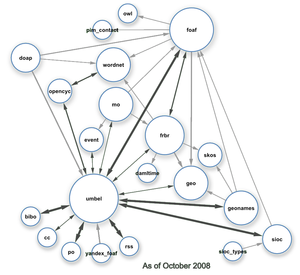
- Image via Wikipedia
It’s a journey of possibilities, the semantic web, and its one we’re all engaged in in one form or another. I’ve been eyeing up the topic for some time, and the third UK ISKO Conference gave me the push I needed to look deeper into what the semantic web and linked data hold for the future.
Last time I was at the ISKO conference, in 2008, many of us there were baffled by the possibilities of linked data. If all this data was to be linked on the web, who would put it out there? Who would put the money up to produce the data? This year, answers to some of those questions emerged. It would appear that linked data is at the point of lift-off, and it’s already being used in ways we can now understand.
I start by looking at some of the ideas behind linked data, and then follow the presentations at the conference, all of which clarified some aspect of the subject and gave us a glimpse of how it can benefit ‘the rest of us’, the users.
The Significance of Linked Data
Linked Data is part of the Semantic Web, and for those wondering exactly what that is, here’s a quick explanation. Semantic Web is the term used to describe a Web environment in which the meaning (or semantics) of information is made explicit and therefore machine readable. Our brains can handle very complex information. When we say we want an apple, we can work out from the circumstances that we want the eating type of apple, not the company Apple or the Big Apple, or an Apple computer. Machines need much more explicit instructions to contextualise the exact meaning of a word. We know that by building up a series of simple instructions, starting with the basic 0 or 1 choice, computers can perform very complex tasks. The Semantic Web, a term coined by Tim Berners-Lee the creator of the World Wide Web, describes an environment in which information can be accessed and processed automatically in an intelligent way. Linked data makes sense of the Semantic Web by providing a framework for a network of related information.
We are accustomed to the idea of HTLM documents located at URL’s (Universal Resource Locators) and linked together by hyperlinks. In the same way smaller bits of information can be assigned URI’s (Universal Resource Identifiers), and these bits of data can be linked using RDF technologies. So we can take the idea of ‘Cat’ and assign it a URI. We can give another URI to a particular cat, say Dick Whittington’s cat. Then we can link the two to increase the amount of information available.
Continues @’ http://electriclane.blogspot.com

Filmtools
Filmmakers go-to destination for pre-production, production & post production equipment!
Shop Now














